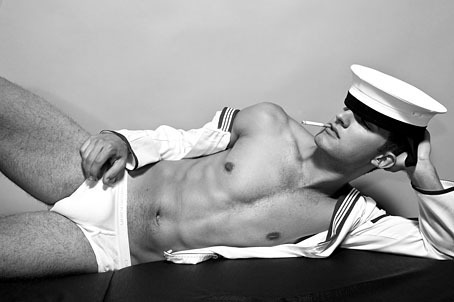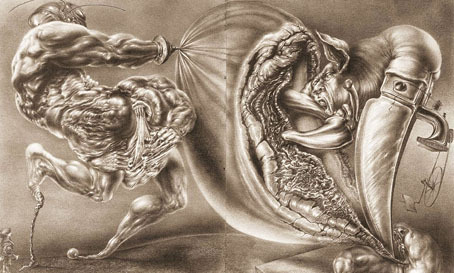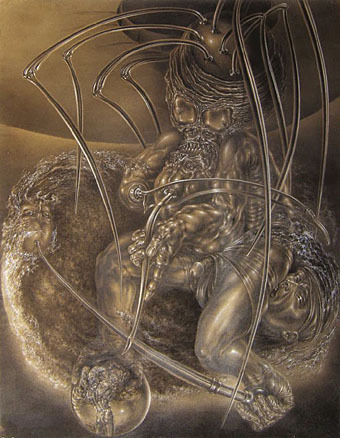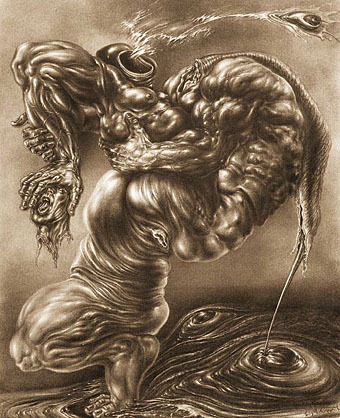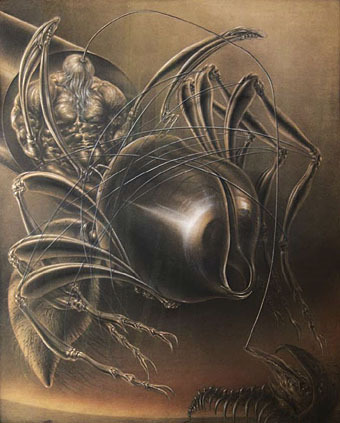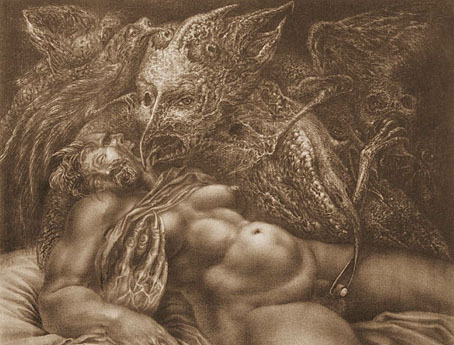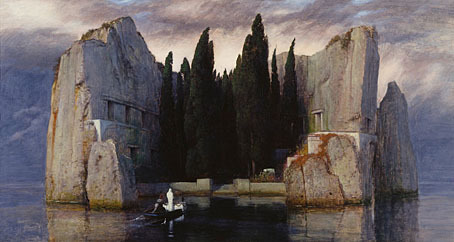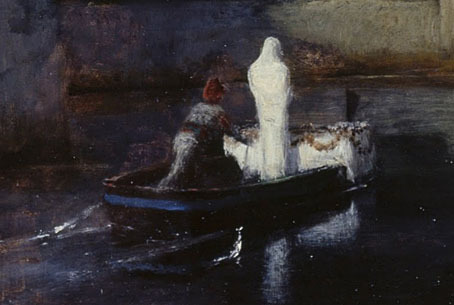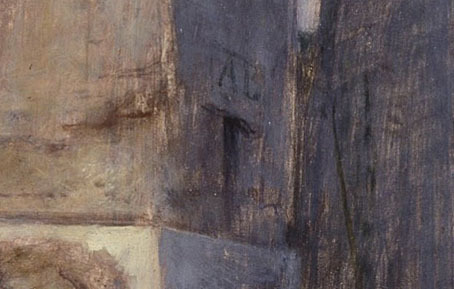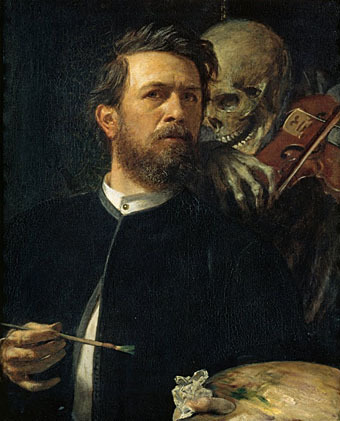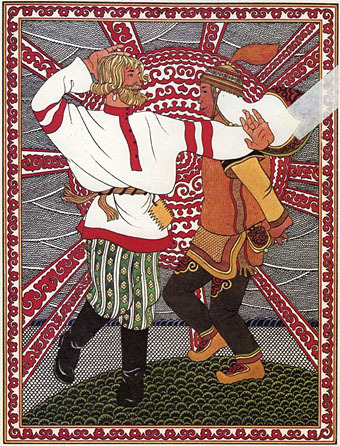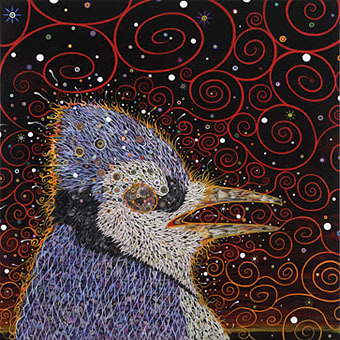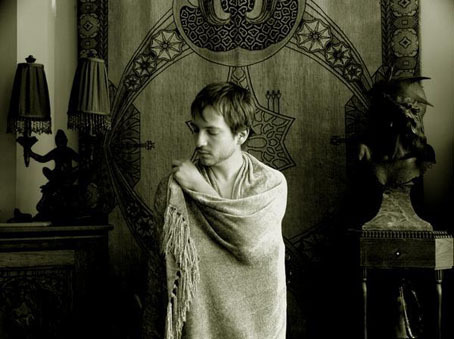John Coulthart's Blog, page 307
June 14, 2011
Hello, sailor
Homotography goes nautical again this week, sporting shots of model Lukas Bossert in a session by Mustafa Sabbagh. I'm not sure whether these have any purpose beyond showing off Mr Bossert's physique but we don't really need any other reason, do we? Homotography has bigger pics should you require them.
Incidentally, fashion photography is now the only place you regularly see photos of anyone smoking, whether posing or otherwise. With the march of prohibition, the cigarette-as-style-fixture seems to have shifted to become a vague signifier of rebellion. The fashion world loves its rebel iconography so I can see this trend continuing for some time, or at least until the habit starts to generate the inevitable complaints.
Previously on { feuilleton }
• Querelle again
• Sailors
• Mikel Marton
• Exterface
June 13, 2011
Sibylle Ruppert revisited
Empusae Raptus (1977).
Another post about this astonishing artist (I'll keep talking about her if no one else does…). The pictures here are taken from the catalogue for the 2010 Sibylle Ruppert exhibition at the HR Giger Museum, Gruyères, Switzerland. Leslie Barany was good enough to send me a copy of this, and the pictures are posted courtesy of the museum. To purchase a copy of the catalogue contact marcowitzig@gigerworkcatalog.com
Le Chant de Maldoror (1978).
Looking over Sibylle Ruppert's work this week I've been pondering why she wasn't better known. She was working throughout the 1970s and could easily have been swept up in the vogue for fantastic art when it was being popularised by Omni magazine. Giger, Mati Klarwein, Robert Venosa, De Es Schwertberger and others all benefited from Bob Guccione's publication, and to a lesser degree from appearances in Heavy Metal magazine. Ruppert's lack of visibility may have been a result of the usual situation whereby women artists were overlooked or marginalised. But I think it's far more likely that her work was simply too intense and visceral for the newsstands. Giger could get by with paintings like the semi-abstract NY City series which were attached to science fiction stories without causing a stir. It's difficult to imagine Ruppert's work gaining such a popular acceptance, especially in the United States where, lest we forget, Giger's Penis Landscape did cause a stir in 1985. One of the great benefits of the web is the way so much previously buried culture is surfacing and finding new and enthusiastic audiences. Sibylle Ruppert's greatest audience has yet to find her but they're surely out there, you can't keep work of this quality buried forever.
For a few more Ruppert works see that haven of all things grotesque, Monster Brains.
Le Spectacle de l'Univers (1977).
Un Archange, une Araignée (1977).
Ma Soeur mon Epouse (1975).
Elsewhere on { feuilleton }
• The fantastic art archive
Previously on { feuilleton }
• Sibylle Ruppert, 1942–2011
• The art of Sibylle Ruppert
June 12, 2011
The Isle of the Dead in detail
More from the Google Art Project where a couple of paintings by Swiss Symbolist Arnold Böcklin (1827–1901) may be explored, one of them an 1883 version of cult favourite The Isle of the Dead. No need to repeat the history of that work when I've already written about it. The version here is from the Alte Nationalgalerie, Berlin, and is the one I've seen reproduced in books the least so it's good to see it in high-quality.
Böcklin painted five versions of this scene, one of which was lost during the Second World War. A couple of them, this one included, have his initials placed over the doorway of a tomb, a detail which isn't always visible in reproductions.
In the same collection is another gloomy Böcklin painting, Self-Portrait with Death Playing the Fiddle (1872), and I hadn't noticed before that the fiddle only has one string, the lowest, which would no doubt create a suitably dolorous melody.
For more on The Isle of the Dead see Toteninsel.net, a site dedicated to the many works in different media derived from the paintings.
Previously on { feuilleton }
• Arnold Böcklin and The Isle of the Dead
June 11, 2011
Weekend links
A plate from Tales of the Amur by Dmitry Nagishkin, a 1975 edition illustrated by Gennady Pavlishin.
• The week in Surrealism: Opera of the surreal gives Dalí an encore: Yo, Dalí, a previously unperformed work by Xavier Benguerel, receives its premier in Madrid. Meanwhile Tate Liverpool's summer exhibition, René Magritte: The Pleasure Principle, is profiled here. "René Magritte has inspired more book covers than any other visual artist," says James Hall.
If Rimbaud anticipated the Surrealists by decades, Ashbery is said to have gone beyond them and defied even their rules and logic. Yet though nearly 150 years have intervened since Rimbaud's first declaration of independence, many readers in our own age, too, still prefer a coherence of imagery, a sameness of tone, a readable sequential message, even, ultimately, what amounts to a prose narrative broken into lines.
Lydia Davis on Rimbaud's Wise Music.
• Umberto Eco's glimpse into the art of the novel | Return to Wonderland: an essay on Lewis Carroll's world by Alberto Manguel | Heavy sentences by Joseph Epstein: On How to Write a Sentence and How to Read One, by Stanley Fish.
And then there's the mystery of what happened to him for those four months in London when we have no trace of him. Rimbaud mentions Scarborough in "Promontory" and talks about "Hotels, the circular façades of the Royal and the Grand in Scarborough or Brooklyn." Since there's that missing period in England, people say he must have gone to Scarborough, and have even checked hotel registers for that period, but as far as I know nobody has ever found anything. Someone even checked railway and train schedules in order to pin him to this real place. I seem to remember a French writer admitting that Rimbaud was never in Brooklyn, but kind of wishfully thinking that he might have been. Which is very funny. "Rimbaud in Brooklyn": there's a project for someone.
A Refutation of Common Sense, John Ashberry on translating Rimbaud.
• Robert Jeffrey posts a video of his nine-year-old self giving Madge a run for her money in 1991. As Boy Culture puts it: "Anyone who feebly clings to the belief that gay can be prayed away should take a look at this and give up already…" Amen.
• The mathematics of Yog-Sothoth: Richard Elwes on Exotic spheres, or why 4-dimensional space is a crazy place.
• For I Will Consider My Cat Jeoffry by Christopher Smart (1722–1771).
• Lesbian pulp fiction, 1935–1978 and Faber 20th century classics.
• As The Crow Flies, a new album from The Advisory Circle.
• New World Transparent Specimens by Iori Tomita.
• 79 versions of Gershon Kingley's Popcorn.
• Minor Man (1981) by The League of Gentlemen.
June 10, 2011
Alchemy & Inquiry
The Dust Blows Forward, The Dust Blows Back (2011) by Fred Tomaselli.
Artistic alchemy has been thriving in New York for the past few weeks. Alchemy & Inquiry is a show which has been running at the Glyndor Gallery, Wave Hill, the Bronx, since April, featuring paintings by Philip Taaffe, Fred Tomaselli and Terry Winters. "Alchemy" here is used in its broadest sense:
The word "alchemy" in the exhibition title alludes to transformation on many levels: chemical, magical and spiritual. Creative powers are summoned to transform common elements physically and metaphorically into substances of great value. With practices and insights that prefigure many important discoveries in biology, chemistry and physics, alchemy likewise fascinated and continues to fascinate poets and painters, serving as an allegory for the physical manifestation of immaterial spirit. This tradition unites the work of Winters, Tomaselli and Taaffe. (more)
A PDF catalogue containing commentary by the always enlightening Peter Lamborn Wilson can be downloaded here. A sample:
Certain extra-formal aspects of art cannot be ruled out as irrelevant to our experience of that art or to our understanding of it. a visitor from Alpha Centauri would not know that Tomaselli's paintings actually contain real pills, maryjane leaves, spore prints, or whatever—real illegal drugs. but we earthlings cannot fail to consider this witty provocation when thinking about Tomaselli's works. to own one of his paintings—if the Feds ever wanted to make an issue of it—would be, simply, a crime. Is a crime, actually. this fact adds nothing formal to Tomaselli's art. but, oh, how much it adds, let's say, conceptually. How much weight? What an aura.
If proof were needed, contra all the puritan anti-drug fascists and priests, that genuine mystical drug states are accessible via entheogenic drugs and various (illegal) ditchweeds, then we could enter Tomaselli's paintings as evidence. the point is that if drugs could not do this then there would be no reason to make them illegal. Imagine: icons that are also reliquaries, containing edible body parts of vegetable saints, forbidden by the Babylonian Ugly Spirit, the eternal Mind Police.
The NYT reviewed the exhibition but missed a trick in not connecting it to the Alchemically Yours group art show which has been running at Observatory, Brooklyn throughout the past month. That show ends this weekend; Alchemy & Inquiry runs until June 19th. Thanks to Jay for the tip!
Previously on { feuilleton }
• Alchemically Yours
• Laurie Lipton's Splendor Solis
• The Arms of the Art
• Splendor Solis
• Amphitheatrum Sapientiae Aeternae
• Cabala, Speculum Artis Et Naturae In Alchymia
• Vision Quest
• Digital alchemy
June 9, 2011
Sibylle Ruppert, 1942–2011
Bible-du-mal (1978).
Another painter gone, and a really extraordinary one at that. I wrote something about German artist Sibylle Ruppert two years ago, and only heard about her death this week following an email from Leslie Barany of Barany Artists. Leslie also sent copies of recent exhibition material from a Ruppert show at the HR Giger Museum in Gruyeres, Switzerland, last year, from which these pictures have been taken. The picture above gives some idea of the intensely visceral nature of her paintings and drawings. Giger owns (or owned) the picture below as he reproduces it in one of his books, along with other works from his personal collection.
Hit Something (1977).
There was an official site for Sibylle Ruppert's work but, as is often the case with artist sites, it appears to now be defunct. This is frustrating since her work isn't very visible on the web at all. Anyone interested could start with this set of Flickr views of the Giger Museum exhibition. She was a fantastic artist in all senses of the word.
The following is a biographical note credited to Alain Robbe-Grillet and taken from the gallery materials. It's presented here as printed:
Sibylle Ruppert was born during an air raid on September 8th, 1942. It was the night of the first massive bombing of Frankfurt during World War II. With a numbered tag around her neck, Sibylle was, immediately whisked from the maternity ward down to the bomb shelter in the basement, while her mother was moved to safety under a supporting column of the hospital staircase.
She spent her infancy between the nursery and an improvised bomb shelter in which plaster fell from the ceiling whenever the bombs hit the neighborhood. In spring 1944 her parents decided to flee Frankfurt for the countryside. Sibylle's first memories were of the shoving and screaming crowds on the platform of the train station desperately trying to climb into the overcrowded wagons.
Although the family spent the remainder of the war in relative security, they were subjected to mistreatment and greed at the hands of the farmers who gave them shelter. After the war they were taken in by an aristocratic family who owned a castle and Sibylle spent her early childhood years as if in a dream world. Her father was a graphic designer and young Sibylle spent hours upon hours near his desk watching as he drew. One day she seized his hand and promised him that she would paint nice colourful pictures just like him. Her first drawing surprised everyone, it was a brutal illustration of a fist stricking the middle of a face – she was 6 years old.
At age of 10 she had a religious enlightment and she insisted on becoming a nun. Only the great efforts of her parents managed to dissuade her from taking up a novitiate. In school she was not the best, except in her art classes where she far surpassed all the other students to such an extent that her instructors could not believe that she painted the pictures by herself. Secretly she took the entrance examination of the Städel Akkademie and passed brilliantly.With the support of Prof.Battke she worked relentlessly and created up to 20 drawings a day.
Sitting immobile, continuosly, behind the drawing board caused her to gain quite some weight, so her mother enrolled her in the neighborhood ballet school. Sibylle tackled her new activity with the same energy and will-power as she did drawing which prompted the school authorities to give her a choice: either art or dance, but not both at the same time. As soon as she turned 18 she solved the problem her own way by escaping to Paris, the city of her dreams, where she enrolled in a dance school in Clichy. During the day she followed the strict regimen of dance classes, but at night she roamed the notorious streets of Pigalle and Montmartre, fascinated by the ambiguous characters in these neighborhoods.
As she was too tall for classical ballet she joined the famous dance ensemble of Georges Rech. This was the beginning of an adventurous life as a revue dancer touring all over Europe and the Middle East. But while her colleagues relaxed Sibylle visited all the local museums and galleries and continued drawing her every free minute. Then all of a sudden, in New York, she decided to give up on her dancing career. She returned to her family in Frankfurt and started working as a drawing instructor at the art school founded by her father.
In addition to her teaching, at night she pursued her own personal work, inspired by the „divine" Marquis de Sade and his frightful universe. Encouraged by notable German intellectuals like Peter Gorsen, Theodor Adorno and Horst Glaser whom she later married her drawings start to become well known. The exhibitions organised by the Sydow – Zirkwitz Gallery in Frankfurt consternated as much the traditional art audience as they produced raised eye brows among the intellectuals.
In 1976 she moves to Paris and exhibits her large format charcoal drawings, inspired by the writings of de Sade, Lautréamont and Georges Bataille, her collages and paintings at the Gallery Bijan Aalam. French intellectuals and great thinkers like Alain Robbe-Grillet, Pierre Restany, Henri Michaux and Gert Schiff show interest and are fascinated by and try to interpret her infernal work. When the gallery closes in 1982 she returns to teaching drawing and painting. She starts giving art classes in prisons, psychiatric institutions and drug rehabilitation centers. Today, Sibylle Ruppert lives a cloistered life, withdrawn from the public, in Paris.
Elsewhere on { feuilleton }
• The fantastic art archive
Previously on { feuilleton }
• The art of Sibylle Ruppert
June 8, 2011
Everything old is new again
Thomas Negovan.
Music journalist Simon Reynolds has been garnering attention over the past couple of weeks with his new book Retromania, an exploration of the thriving revivals and resurrections in the musical world and an examination of what this may mean for the future. There's an astute discussion along these lines between Reynolds and Colin McKean over at The Quietus (and it is a discussion for once, rather than the more usual Q&A). The debate is a pertinent one but seems a little insular in its focus on music alone, and pop music in particular. Other creative disciplines have been dealing with questions of influence and originality for some time, they only seem pressing concerns in the musical world because so much music from all nations and eras is now available, and pop as a form is still relatively young.
In addition to the rear-view mirror approach to musical creation, there's another side to retromania in the present fascination with antique musical instruments and recording equipment. The Cramps once declared that they preferred valve amplifiers because valves "turned the music to fire"; amps containing silicon chips, on the other hand, deadened the music by routing it through pieces of stone. There's a lot of this attitude around at the moment (organic analogue versus inorganic digital), not least the persistent fetish for analogue synthesizers which dates back as far as 1995 and the Node project. That said, you'll have to work hard to find anyone pursuing a retro aesthetic with greater determination than Thomas Negovan, a Chicago musician intent on releasing a 4-track EP which has been recorded directly onto wax cylinder using an 1894 Edison recording machine. Negovan and co. plan to release the recording on vinyl (with no digital technology used in the transfer), and also release a single on wax cylinder, a medium which they say hasn't been used in this way since 1924. They still need some funding so there's a Kickstarter page for the project here, and more details about Mr Negovan's music over at his MySpace page.
Lastly, and quite by coincidence, The Wire's website has been running Antique Phonograph Portal links this week, including mention of a wax cylinder preservation project at the University of Santa Barbara. Go here, here and here for further details.
Previously on { feuilleton }
• Obsolete formats continued
• Old music and old technology
June 7, 2011
Martin Rushent, 1948–2011

Pop music is one of the best forms of time travel when it summons a memory that returns you to a specific time and place. All I need to revisit the summers of 1981/82/83 is a blast from one of these albums, each one a Martin Rushent production that benefited from his expertise with synth and drum-machine programming. Much as I enjoyed Dare, I tended to play Love and Dancing a lot more, a follow-up to the League's finest album that was dimissed at the time as a quick cash-in but which was a perfect dub of the album proper, pieced together from extended mixes released on the 12″ versions of the singles. Rushent was an early master of the extended mix, a side of his production skills I've not seen mentioned in the obituaries circulating this week. Reggae artists had been doing this for years but Rushent was ahead of the game in turning successful pop songs inside out, extending tracks without taxing the patience of the listener.

One of Rushent's pet projects in the mid-1980s has also fallen by the wayside in the career retrospectives. Hard Corps were an outfit comprising three British guys and one French woman, Regine Fetet, who presented themselves as a kind of UK answer to Computer World-era Kraftwerk, albeit with more eros than Kraftwerk generally manage. Their sound was a combination of hard electronics and pop tunes which I found irresistible but the rest of the world stubbornly resisted, being too hard for the pop crowd and too poppy for the second geneneration Industrial crowd. (Propaganda were doing something similar during this period, and also managing to alienate too many people to be anything more than a cult success.) Martin Rushent produced two of Hard Core's singles including the closest they got to a hit, Je Suis Passée (1985). There's a site devoted to the group here.
• Altered Images: I Could Be Happy (extended mix) (1981)
• Pete Shelley: Homosapien (elongated mix) (1981)
• Pete Shelley: Witness The Change (dub mix) (1981)
• The Human League: Don't You Want Me? (1981)
• The League Unlimited Orchestra: Hard Times (1982)
• Pete Shelley: What Was Heaven? (1983)
Previously on { feuilleton }
• A Secret Wish by Propaganda
• A Clockwork Orange: The Complete Original Score
June 6, 2011
Polish Book Cover Contest Winners

50 Watts (formerly A Journey Around My Skull) followed its 2009 Evil Orchid Bookplate Contest with a contest to design a Polish book cover. The results were announced a few hours ago, the winner being the above design by Ben Jones who happens to be from Manchester. The rest of the entries can be seen in this Flickr set. I'm astonished at the variety on display, and also the success of the majority of these pieces as both cover designs and pastiches of an idiosyncratic style. Nice to see so many people using non-digital techniques, Ben Jones included, and there's an additional pleasure with this challenge in seeing the titles people have chosen to illustrate. Congrats to Will on an inspiring contest.
Elsewhere on { feuilleton }
• The book covers archive
Previously on { feuilleton }
• The Evil Orchid Bookplate Contest
• Polish posters: Freedom on the Fence
• The Robing of The Birds
• Franciszek Starowieyski, 1930–2009
• Czech film posters
• Czech book covers
June 5, 2011
Carl Corley

The Purple Ring (1968).
I've not read any of Carl Corley's novels but their covers become familiar once you start searching through archives or articles devoted to the gay pulps of the 1960s. Corley was unusual in this field in authoring his books under his own name (most gay and lesbian pulps are credited to unlikely pseudonyms) as well as providing the cover art for each title. His paintings try for more of a distinctive look than the usual standard of the time— generally two half-dressed guys pouting at each other—but then he was illustrating his own work so could tailor the art for the story. This kind of fiction is a lot more visible now than it used to be, attracting the attention of queer historians and academics, but there's still no dedicated site for many of these artists and writers beyond Gay on the Range. There's a couple more Corley covers on Flickr (here and here) but for now The Haunted Lamp seems to have the best collection.
Elsewhere on { feuilleton }
• The gay artists archive
• The book covers archive
Previously on { feuilleton }
• Sherbet and Sodomy
• Bugger Boy
• Gay book covers
John Coulthart's Blog
- John Coulthart's profile
- 31 followers


